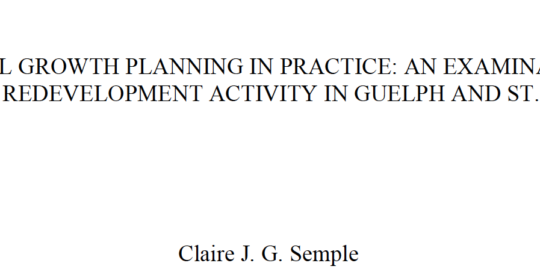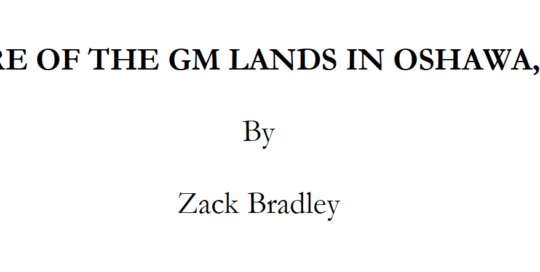April, 2021 Research from the Field: Columns written by students that briefly summarize academic research articles on brownfields redevelopment. Please click on the titles to access the article. Affordable Housing on Brownfield Sites by R. Tom Tax Increment Financing by C. Semple Climate Resilience and Coastal Brownfield Redevelopment by Frederico Palacios Green Urban Brownfields by C. Murphy Social Sustainability in Brownfield Redevelopments by J. Bevaqua

REGIONAL GROWTH PLANNING IN PRACTICE: AN EXAMINATION OF BROWNFIELD REDEVELOPMENT ACTIVITY IN GUELPH AND ST. CATHARINES
Christopher DeSousa 2021-07-13T08:13:58-04:00April, 2021 REGIONAL GROWTH PLANNING IN PRACTICE: AN EXAMINATION OF BROWNFIELD REDEVELOPMENT ACTIVITY IN GUELPH AND ST. CATHARINES For many cities, brownfield properties are an underutilized land resource. As a part of a comprehensive policy approach, A Place to Grow: A Growth Plan for the Greater Golden Horseshoe, encouraged development on brownfield sites to fulfill urban intensification goals and support regional sustainable growth objectives. Distinguishing between policy and practice, this study examines the extent to which brownfield redevelopment activity in two mid-sized cities, Guelph and St. Catharines, follows sustainable growth objectives and the implements the intent of the Growth Plan. Results were drawn from analysis of Records of Site Condition (RSCs) filed on the Province of Ontario’s Environmental Site Registry, Community Improvement Plans and visual site inspections. Overall, brownfield redevelopment occurred in locations identified by the Growth Plan and achieved infill purposes, although the abundance of greenfield land in Guelph presented significant challenges. While market mechanisms remained a determining factor in both cities, St. Catharines appeared to better influence sustainable character in redevelopment activities. Recommendations to facilitate brownfield redevelopment and support sustainable growth objectives [...]
THE FUTURE OF THE GM LANDS IN OSHAWA, ONTARIO
Christopher DeSousa 2020-05-13T17:24:33-04:00April, 2020 THE FUTURE OF THE GM LANDS IN OSHAWA, ONTARIO The 2019 closure of a General Motors Assembly in Oshawa, Ontario has left a large site available for redevelopment in the GTHA. While most discussions on this topic have focused on the job loss and economic impact on Oshawa, there have been no formal discussions about the development potential of this land. This paper seeks to challenge local stakeholders to reimagine the future of the GM Lands, as well as Oshawa as a whole, by providing case studies of post-industrial developments. This paper combines these case studies with a deep examination of the current economic, political, and planning situation in Oshawa and a dive into the history of brownfields for both the City of Oshawa and for General Motors. ACCESS THE FULL MRP
Catalytic Brownfields, Final Report
Christopher DeSousa 2020-05-04T15:45:02-04:00April, 2020 Catalytic Brownfields, Final Report Students from Ryerson University, under the guidance of the Canadian Brownfield Network (CBN), have created a consulting team to develop analysis based on brownfield development in order to actualize the catalytic effect. The Catalytic Brownfields Consultants (CBC) have committed to conducting thorough research for the purposes of developing cohesive and common factors that have led to brownfield redevelopment projects being catalytic within a community. Through our research, we have identified themes that encompass the catalytic nature of development that can be applied to brownfields across Canada. The revitalization of brownfields in a city will not only improve the area that is being redeveloped but will allow for new housing choices, a better quality of life, mitigation of health risks and the creation of new job opportunities. A vacant and contaminated site can account for a significant loss in property taxes and diminished value in land. Most brownfield development processes are time-consuming, and in most areas, undetermined, the need for environmental remediation is evident. Therefore, finding a set of successful brownfield redevelopment projects which have an effect of being [...]
TAX INCREMENT FINANCING FOR BROWNFIELD REDEVELOPMENT
Christopher DeSousa 2020-03-20T21:02:09-04:00November, 2019 Tax Increment Financing for Brownfield Redevelopment The Canadian Brownfield Network (CBN) engaged Ryerson University’s graduate planning students (the Project Team) to develop a Tax Increment Financing (TIF) approach for brownfield development in Ontario. Specifically, CBN was interested in a market-based model for TIF similar to the model used in Michigan. The Project Team looked closely at how TIF is legislated and operationalized in Michigan as a potential model for Ontario. Between September and November 2019, the Project Team engaged with public and private stakeholders to determine how TIF can be implemented and what the regulations could resemble. The Project Team conducted over 20 interviews with members of staff from the Province of Ontario, municipalities across Canada, and brownfield practitioners from Ontario including: private developers, quasi-government agencies, and financial lenders. In addition to these interviews, the Project Team conducted an analysis of existing academic literature, as well as policy and regulatory frameworks, for brownfield redevelopment and the use of TIF in Canada and the United States. SUMMARY Access the Full Report
Reactivating Cornwall: A Closer Look at Gas Station Brownfields
Catherine Huynh 2019-07-10T17:51:56-04:00April, 2019 Reactivating Cornwall: A Closer Look at Gas Station Brownfields This report was prepared by third-year Ryerson University students enrolled in PLG 620: Advanced Planning Studio I at the School of Urban and Regional Planning. The purpose of this report is to develop an approach for the Planning, Development, and Recreation Division of the City of Cornwall to prioritize former gas station sites within their brownfield inventory. By applying a context-based selection criterion, and proposed potential concepts for a leave-as is use, beatification use, interim use, and redevelopment, the brownfield with the greatest development potential can be targeted. Communities across the province have been left with the responsibility of discovering innovative ways to manage their abundance of abandoned developments, as the anticipated time and resources required for remediation are not always reliable due to unforeseen contamination. SUMMARY Access the Full Report
Studio 620
Catherine Huynh 2019-07-08T20:04:08-04:00June, 2018 Unlocking Brownfield Opportunities This report was prepared by third-year Ryerson University students enrolled in PLG 620: Advanced Planning Studio I at the School of Urban and Regional Planning. The studio is conducted in consulting teams reporting to a faculty member (Chris De Sousa) addressing the needs of the client (The Canadian Brownfields Network). The group was tasked to examine all federal, provincial and territorial policies and regulations relating to brownfields remediation and redevelopment throughout Canada. Factors examined include liability and financial structures, regulatory processes, provincial and municipal programs, remediation techniques and standards, stakeholder involvement, and current federal and provincial government involvement and strategies in brownfields. Access the Full Report





